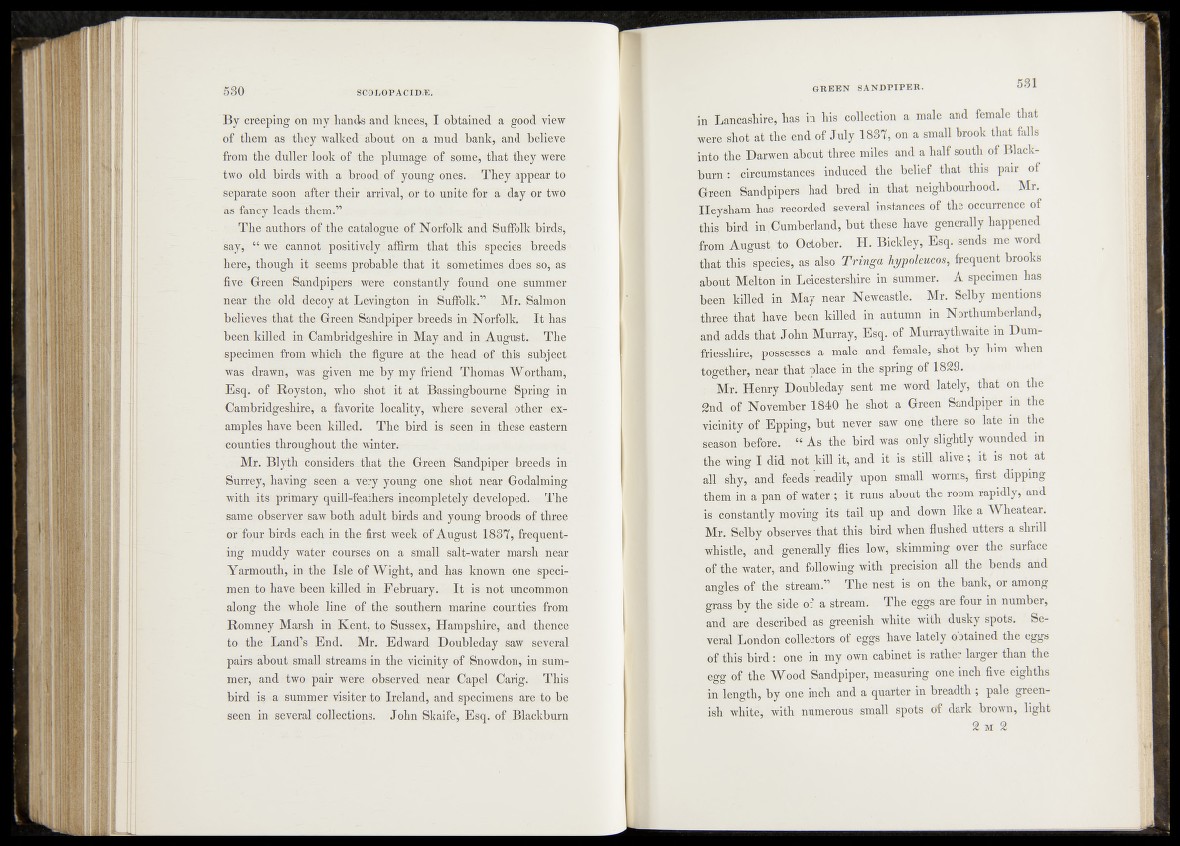
By creeping on my hands and fences, I obtained a jiievr
of them as they walked about on a mud. bank, and fjbefeve
from thé duller look of the plumage of some, that they were
two old birds with a brood, of young ones. They appear to
separate soon after their. arrival, ;or to unite for a day or two.
as fancy leads them.”
The authors of the catalogue of Norfolk and Suffolfobirds;
say, “ wc' cannot positively.; aflirm that ibis* spiofosiihreeds'
here, though it seems probable that it sömetimés^does so,; as -
five- Green Sandpipers were constantly found one summer
near the old decoy at Levington: anr»’Suffolk.” Mr. jpateon
believes that the Green Sandpiper-.breeds-in * Norfolk, uTtdias
beenikilled in Cambridgeshire in May andepn August. S-The
specimen from which the.bgure.at-the head'of thl&.vsiibj>ect
was drawnV. - '^ i ^iven me by my^friéndr Thoihas ?M%tthamr,
Esq. of Royston, who shot fit at Rassingboume Spring in
Cambridgeshire, a favorite locality, where :sev©r#ri0^ietO'^T
amples have-been killed. The'bird is^seém iriuthbse eastern
counties throughout the winter.-
Mr. Blyth considers .that the Green,- Sandpiper breeds! in
Surrey, having, seen a-very young One shot near Godalming
with its primary quill-feathers incompletely 4'fve|oped-’ The
same observer saw both adult bfrds and: youn.göbroodébf;|fehreê
or four birds each in the first week" öf August 1837, frequenting
muddy water courses on a small salt-water inarshafréar
Yarmouth, in the Isle of Wight, and has known one .specimen
to have, been killed in February. I t is n o t uncommon
along the whole line of .the southern marine couiiti^ from.
Romney Marsh in Kent, to Sussex, Hampshire, and thence
to the Land’s End. Mr. Edward Doubleday saw several
pairs about small streams in the vicinity of Snowdon, in summer,
and two pair were observed near Capel Carig. This
bird is a summer visiter to Ireland, and specimens are to be
seen in several collections. John Skaife, Esq. of Blackburn
to Lancashire, has in his: collection a male and female that
Mete sh d ia t the -end of July i m , on a small brook that falls
into the. Darwen about three miles and a half south of Blackburn
: circumstances^ induced the belief that this pair of
Green Sandpipers - had bred in that neighbourhood. Mr.
Hey sham' has Recorded,.several instances of the occurrence of
this* bird ^Cumberland, but these :have generally happened
fr.om#ugust, ;to idfotobens >H. Bickky,-Esq. sends me word
that th isl^ |^ e s$ .0fafeo: Tringa hypoleucos, frequent brooks
about-Melton imLejeestersbite in summer. A specimen has
been k illefdn May near,^Newcastle; ^ Mr. Selby mentions
t h r e e ^ t y h a a ^ i e ^ killed, in autumn: in Northumberland,
and- adds.:that Jolin Mu rray ,.E sq ||f Murmythwaite in Dumfriesshire,
spOssessesv a male and female*ishot, by him when
togetfreS^near that .place indite-spring- of 182&..'.
Mr. Henry Doubleday :scnt. me word lately, that on the
2nd‘‘©»b,vember 1840 h e ’shot,a Green Sandpjper in the
fvifeiufoy of Epping, bust mever saw, one there?so,late in the
seasmkbefore. bird was only slightly wounded in
the wing-1 did toot .k ffl.^ian d ' i t -is*, stii* alive*,; i t is not at
all sBy, .and feeds 'readily upon small worm's, first dipping
them in a.pan ofr water.;’ itrruns aboutithe room rapidly, and
d^depnstantly .moving its. tail -up and down like a Wheatear.
Mr. ‘^SelbydobserveaHhat this bird when %shed Utt^-s a shrill
whistle, and genei^yufltes'low,- skimm%i.«ver the surface
of the water, and. following with precision all the bends and
angles of th e stream.’V The. nest is on the bank, or among
grass b y ih e .side of a stream. The eggs are four in number,
and are' described as greenish white with dusky spots. Several
London collectors of eggs have lately obtained the eggs
of this bird : ione .in my own cabinet is rather larger than the
egg of the. Wood Sandpiper, measuring one inch five eighths
in length,; by one: inch and a quarter in breadth ; pale greenish
white*, with numerous small spots df dark brown, light
2 m 9,